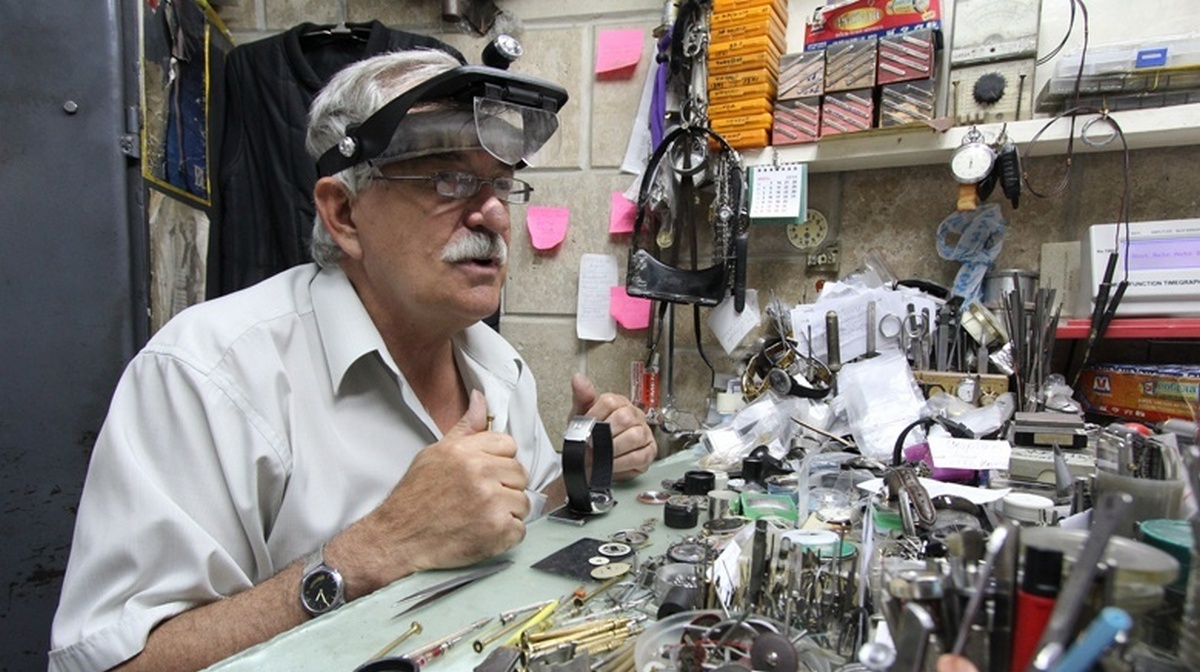Rating of the best anemometers for 2025
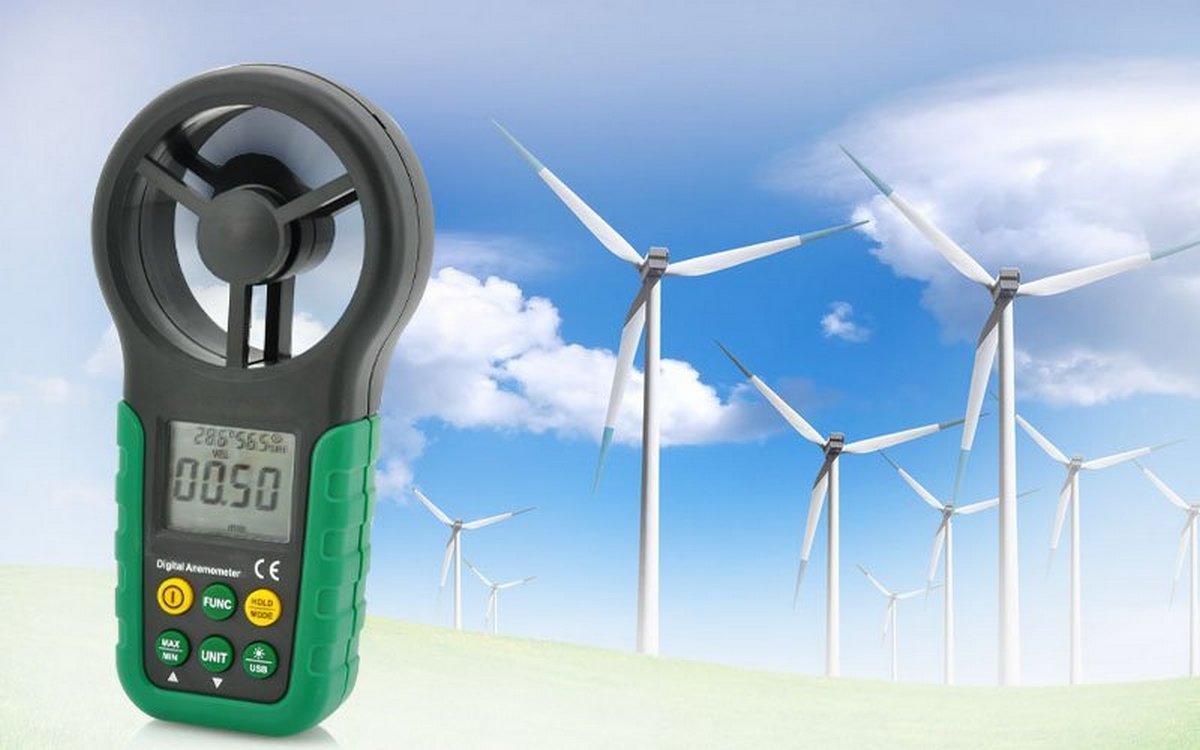
An anemometer (or wind meter) is a device that is able to show the speed of air flow. In the modern world, there are variations of it, which also display the temperature of the moving stream. Most of them are manufactured in the factory, but, if desired, the simplest model can be made independently. The scope of their application is quite extensive and largely specific.

Content [Hide]
- 1 Anemometer - general information
- 2 Variety of models and their classification
- 3 Popular options for wind meters
- 4 Differences between different types of devices
- 5 Choice problems
- 6 A few tips for use
- 7 Rating of the best anemometers for 2025
- 8 Instead of an epilogue
Anemometer - general information
Today, anemometric devices have gone far from their original purpose - now they can measure not only wind speed, but also the speed of various gases. Thus, its specialization has expanded significantly and the device can be used not only for scientific meteorological purposes, but also have an applied purpose, for example, to determine wind speed at airfields and helipads, to determine storm gusts in ports, to establish the possibility of construction work on high-rise buildings, as well as the movement of harmful gases in the ventilation of mining mines. The units of measurement for these instruments are set in meters per second.
If earlier the device was an exclusively stationary object, today there are its mobile versions, which are perfect for transportation and use in hard-to-reach places.
Principle of operation
The measurement of the speeds of movement of the air mass or gases, as well as the output of the obtained data, their conversion into the necessary units, is carried out by three structural elements of the apparatus:
- Measuring element - by means of excitation of its sensors, direct measurements are made, which is carried out with the help of ultrasound, metal cooling, pressure drops, radiation intensity;
- Transforming element - the obtained physical quantities are transformed into some kind of energy form;
- Fixing element - consists of dials, counters and indicators that visually display the results.
Variety of models and their classification
Depending on the principle of operation and design features of the wind meter, they can be divided into electronic, mechanical and ultrasonic:
- Mechanical - due to the movement of air masses in their design, the rotation of individual parts (blades) occurs. This category includes cup and winged (blade) samples. Between themselves, they differ only in the shape of the element for capturing incoming air - it is either a blade or a bowl.
- Heating or thermal - they contain a heating sensor, as a rule, which is an ordinary incandescent wire, which, in the process of exposure to moving air masses, cools down. Based on the indicators of the decrease in the heating temperature of the sensor, a measurement is made. Refers to electronic versions.
- Ultrasonic - their measurements are carried out on the basis of determining the speed of the acoustic wave. That is, sound, moving through a gas cloud (air) in an excited state, will have a different speed. When it moves towards the wind, its speed decreases. Otherwise, the speed of sound increases. On the basis of this physical phenomenon, measurement is carried out.
Existing classification
Among other things, anemometer models can be classified according to the type of sensor responsible for interacting with the air flow. On this basis, they are divided into:
- Rotating - when interacting with the wind, certain parts of the structure begin to rotate depending on the strength of the latter;
- Acoustic - capable of measuring sound speed;
- Thermal - operating within the temperature difference of the measuring element;
- Optical - complex devices that require the presence of a special object in the moving stream, from which the laser beam will be reflected, on the basis of which the measurement is made;
- Dynamic - based on the principle of the Pitot-Prandtl tube, where the speed is measured based on the difference in pressure between the incoming and outgoing streams.
IMPORTANT! The last two principles of operation are actually used only in scientific research and are of little practical importance, since the high-precision results obtained by them in everyday life will not be of great importance.
Popular options for wind meters
winged
This type of device is the most common and is capable of producing results of sufficient accuracy, which are suitable for both domestic and industrial purposes. These models are most widely used in the following industries:
- At meteorological stations (for the purpose of observing changes in weather phenomena);
- At airfields (to determine the possibility of flights);
- In mining ventilation systems (to determine the level of proper air draft output);
- In the construction industry (to measure the strength of the air flow when working at height, for example, in order to determine the admissibility of work on tower cranes);
- In the agricultural industry (to determine the possibility of treating crops with protective chemicals and fertilizers from the air).
IMPORTANT! Most winged (vane) devices are capable of measuring wind speed in various planes, while simultaneously measuring air temperature.
The device of bladed models includes three main blocks:
- The module responsible for measuring the wind speed in a state of so-called rest. Simply put, the module captures the degree of perturbation of the air mass as it passes through the blades.
- The module responsible for the conversion - it is he who serves as a "translator" of the received data into physical units.
- Module responsible for logging - the data received from the transducer is visually recorded for ease of reading by the operator.
Cup
These wind meters are adapted to measure only in the plane that is directly perpendicular to the rotational axis of the bowl. Traditionally, the device has four bowls, made in a hemispherical shape, located on a cruciform rotor spoke and having symmetrical dimensions. Cup hand devices are able to count the number of turns of the cross made in a certain time period. Their improved versions are also equipped with various types of tachometers in order to improve the quality of the results obtained. Measurements are taken instantly in real time, and the measurement accuracy is from 0.2 to 30 meters per second.
Thermal
Their principle of operation is to measure the electrical resistance on a wire gauge. This indicator changes depending on the temperature of its heating, which decreases in conditions of too fast air flow. Structurally, it is a metal filament made of tungsten, silver, nichrome or platinum (or other metal).This thread is heated by electric current to a temperature that must exceed the current ambient temperature. The main disadvantage of wind meters of this type is their very weak resistance to strong mechanical influences.
Ultrasonic
Their principle of operation is based on measuring the speed of sound in a restless gas flow, which is carried out on the basis of the laws of physical acoustics. Thus, if sound propagates in the same direction as the air mass, then its speed increases, and vice versa, when it is opposed to the direction of air movement, its speed decreases. Based on the obtained difference, the time interval of the response of the ultrasound pulse is measured.
This device is the most modern and, as a rule, is equipped with electronic controllers for the output of the results. The sensor itself is capable of performing several functions (depending on its type):
- Two-dimensional sensor - provides data on the direction and speed of the wind flow;
- Three-dimensional sensor - will be able to determine all three elements of wind speed;
- Four-dimensional sensor - in addition to the above functionality, it can also set the temperature of the air flow.
Ultrasonic models are able to withstand wind speeds up to 60 meters per second.
Differences between different types of devices
The most important difference between a mechanical device and an electronic one is that for the first one you will need to manually record the revolutions produced by the measurement sensors, and then independently make calculations using the appropriate formula. For electronic anemometers, this action is not necessary, because. All calculations are made by the electronic controller.Moreover, electronic versions have increased sensitivity and can simultaneously record three parameters:
- The current speed of the air mass;
- Its maximum gusts in a given period of time;
- Carry out the calculation of averages.
Separately, it is worth mentioning anemometers, whose measuring part is made as a special probe and, relatively speaking, is placed outside the main body. It is much more comfortable for the operator to use such devices, because directly during the measurement, you can track the dynamics of changes in indicators. This technology is most often used on rotating models and the measuring module is connected to the main body with a cable. Additional equipment of the anemometer with an electronic controller with its own memory will not be superfluous when permanent storage of results is required, including time, place and measured values.
IMPORTANT! It is worth noting that any anemometer is the subject of measurement, therefore, on the territory of the Russian Federation, compliance with the conditions for their certification and compliance with state standards is required!
Choice problems
Always in the process of acquiring a new anemometer, you should decide in what conditions it will be used and for what purposes. It is best to pay attention to the following points:
- Technical parameters (in what range will it be necessary to measure the speed of movement of air masses - high-speed or will the movement occur at low or medium speeds);
- Accuracy characteristics (for the production of ultra-precise measurements in the laboratory, it is preferable to use dynamic or laser models);
- Potential probability of occurrence of warranty cases (for example, when speed limits are exceeded);
- The design and strength of the hull;
- The quality of the measuring sensors;
- Additional equipment.
The presence of an additional option will always play in favor of the operator, because it will not require the purchase of additional equipment, such as humidity sensors, temperature or tachometer. Separately, you need to pay attention to the units of measurement - for samples of foreign production, they can be in a different system, not only different from the metric one, but measurements can also be made according to other physical scales that are not accepted in the Russian Federation.
price issue
The current Russian market segment is able to offer cheap models of wind meters, which will cost the user in the region of 1,500 - 2,000 rubles. These are devices with a traditional design, with a high degree of error, coupled with a small optional functionality. The most preferred purchase are devices with a cost of 8,000 - 10,000 rubles. They, as a rule, give a fairly high accuracy of results, have protective shells on their bodies, which makes it possible to use them in aggressive environments. Professional devices, with a cost of 20,000 rubles or more, are in demand in industrial sectors (construction and agriculture), because they have extremely wide functionality, have minimal deviations from actual measurements, additional devices are standardly supplied with them.
A few tips for use
Before you start working with the device, you should carefully examine its controls.For most devices, the very principle of operation may be standard, but the designations on its recording modules and the type of final results provided may be different.
It is also worth familiarizing yourself with the operating conditions recommended by the manufacturer - this is necessary in order to eliminate the risks of premature failure of the device. For example, some manufacturers expressly prohibit the use of their product under direct ultraviolet rays. It must always be remembered that the wind meter is an accurate measuring device, and any external influence on it may well affect the accuracy of the results. The same can be said about the presence of an excessive amount of dirt and dust in the measured air masses - this circumstance is especially important for mechanical devices. Thus, the mechanical wind meter, prior to the start of measurements, must be in a state of perfect cleanliness.
At the same time, the anemometers should not be subjected to prolonged work loads. And before starting any research, the wind meter should be verified:
- Inspect it for external damage;
- Check the correctness of the received data in gentle conditions;
- Test the nodes responsible for outputting the results.
Rating of the best anemometers for 2025
Budget segment
3rd place: Benetech GM816
votes 0
A good option for its budget segment. Able to register the state of "rest" of the air mass - from 0.3 meters per second. The permissible error cannot be more than 2%. The declared operating ambient temperature is from -15 to +55 degrees Celsius. The model is easy and simple to use, and the presence of an electronic scoreboard makes the removal of results a very simple process.The country of manufacture is China, the recommended cost for retail chains is 990 rubles.
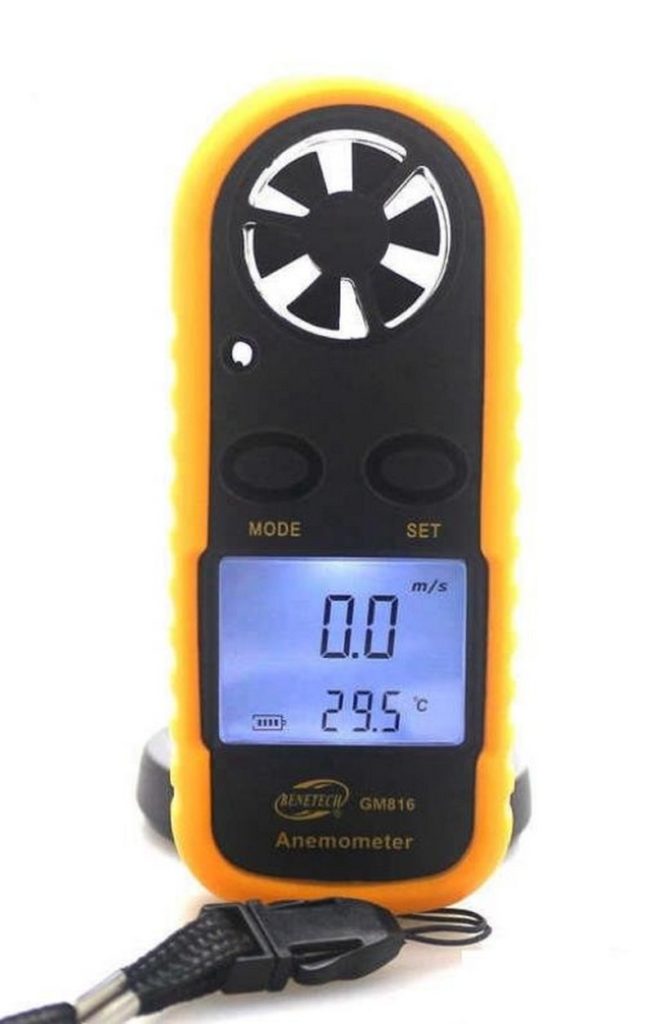
- Extremely budget price;
- Sufficient operating temperature range;
- Wide use.
- The error when working at height can reach 5%.
2nd place: "ADA instruments AeroTemp 30"
votes 0
This device is characterized by its high sensitivity, which, however, affects the accuracy, because the error is set at 3%. Powered by three "little finger" batteries, the charge of which is enough for 60 hours of full operation. Separately, the manufacturer equipped the device with the ability to make measurements in various systems. The digital display is able to vary its own brightness depending on the ambient light. Additionally equipped with a temperature sensor. The country of origin is China, the recommended retail price is 2000 rubles.
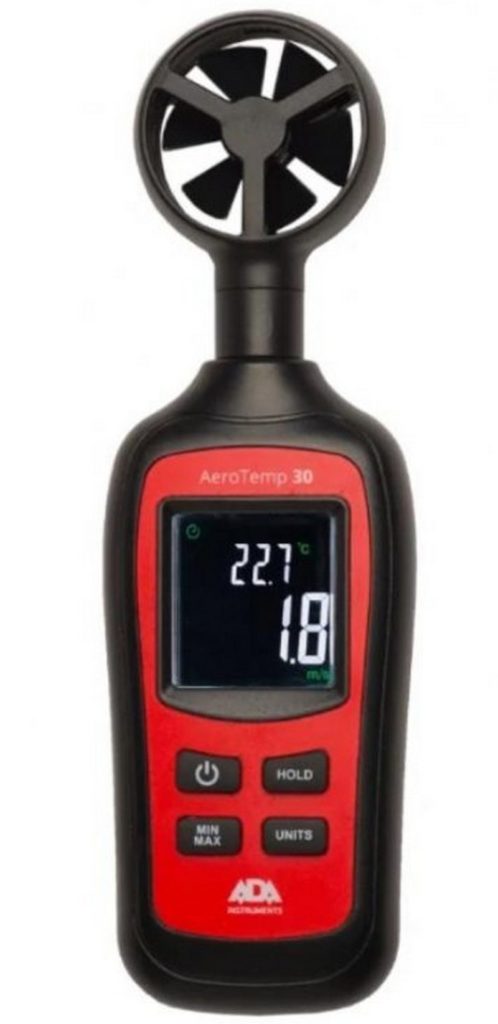
- Ability to work in various measuring systems;
- Convenient body;
- Increased sensitivity.
- Has a 3% error.
1st place: "AMTAST AMF006"
votes 0
This vane wind meter is best used in small spaces. Perfect for measuring the air flow emitted from an industrial fan to a computer cooler. The measurement error is 2%. However, it will increase when using the device at height or in open spaces. Optionally, it can be equipped with a remote measuring module. The country of manufacture is China, the established cost for the retail network is 2400 rubles.
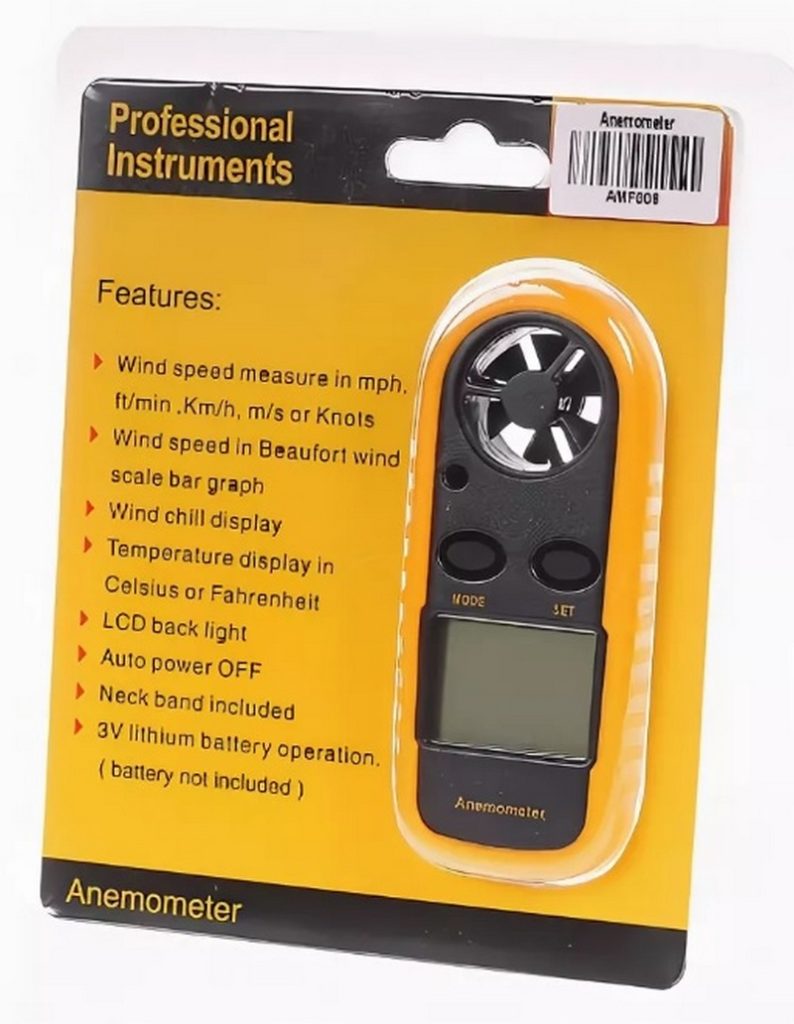
- Ability to connect a remote module;
- Specialized functionality;
- Increased sensitivity.
- Not found.
Middle price segment
3rd place: "MEGEON 11006"
votes 0
An excellent multifunctional option from a Russian manufacturer. Its most important advantage is the ability to work in various measurement systems: land and nautical miles, meters and even feet. At the same time, the installed temperature sensor reproduces temperature values in Kelvin, Fahrenheit, and Celsius. It is very sensitive with "calm" air currents, so the measurement can be started from a speed of 0.1 meters per second. It is worth noting that, depending on the spatial application, the error varies from 1 to 3 percent. The device itself runs on a single 9-volt battery. The country of origin is Russia, the established cost for the retail network is 5000 rubles.
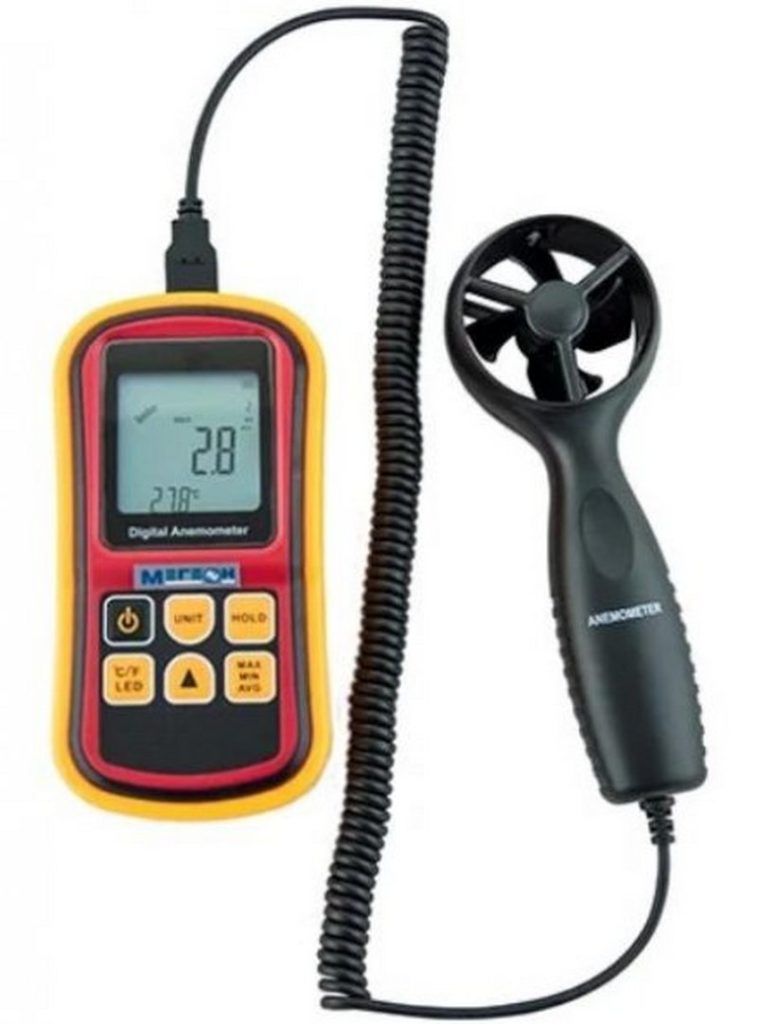
- Variability of metric systems;
- The presence of a temperature sensor;
- Remote module for measurements.
- The battery only lasts 10 hours.
2nd place: "WindLiner ATI-30"
votes 0
This device is extremely small-sized, despite the fact that it has a remote module, and therefore, its transportation is not particularly difficult. The wire with which the impeller is connected to the body can reach 2 meters, and its spring base does not allow it to get tangled. Operating temperature ranges from -10 to +45 degrees Celsius. The initial speed for measurement is set to 0.3 meters per second, which indicates its industrial purpose and the ability to work at heights and large open spaces. The error for industrial conditions of use is tolerable - only 3%. The country of origin is China, the recommended cost for retail stores is 6,000 rubles.

- Industrial orientation;
- Small dimensions;
- Spring wire.
- Somewhat overpriced.
1st place: "MEGEON 11005"
votes 0
Another excellent representative of Russian production. The electronic controller of this device is capable of not only taking measurements, but also storing the results. It is worth noting that most devices that have a save function have only a few memory cells that are overwritten as they fill up. The same model has 500 such cells, so it is very convenient to calculate the averages for several days. Initial work is carried out at a speed of 0.2 meters per second, and the permissible error is kept at 2%. The country of origin is Russia, the recommended retail price is 7400 rubles.

- A large number of memory cells;
- Rugged housing;
- Excellent value for money.
- Not detected.
Premium Samples
3rd place: "Testo 405"
votes 0
This device belongs to the category of digital and belongs to the thermal group of measurements. Equipped with a special antenna, it is able to give the most accurate results. It can detect even the smallest drafts in ultra-small areas up to a few centimeters. The antenna itself is mounted on a flexible rod, which allows the anemometer to be used at any height and in hard-to-reach places. The data displayed on the recording display is the most informative. It can be used in the research and scientific field.The country of origin is Germany, the recommended retail price is 10,000 rubles.

- High accuracy;
- Great functionality;
- Increased reliability indicators.
- Not detected.
2nd place: "CEM DT-8880"
votes 0
This multifunctional device can determine not only the speed of the air flow, but also its temperature with direction. Moreover, measurements can be made even in small closed areas. On the remote rod, connected to the body with a strong wire, there is an ultra-sensitive sensor, made on the basis of a thin string heated by electricity. All this increases the accuracy of the obtained indicators. The antenna itself is telescopic, so it can be used both at height and in hard-to-reach places. The country of origin is China, the recommended retail price is 12,900 rubles.

- Increased accuracy;
- Telescopic antenna;
- Small dimensions.
- Extremely high price.
1st place: "Testo 410-2"
votes 0
Despite the fact that this model is made on a paddle base, its electronic filling allows you to achieve high accuracy results. Wind speed can be measured from 0.2 meters per second with an error rate of 1%. The operation of the device is carried out only from 2 "finger-type" batteries, which are more than enough for 80 hours. The body itself is ergonomically designed and has a high class of protection against external influences - from mechanical shock to moisture and UV resistance. During transportation, the paddle mechanism is securely closed with a special cover, which eliminates the adherence of dust and dirt that can interfere with measuring accuracy.The country of origin is Germany, the cost in retail chains is 16,000 rubles.

- Increased degree of security;
- The accuracy of the electronic filling;
- Quality Western European brand.
- High price.
Instead of an epilogue
The conducted market research has established that the lower segment is completely conquered by Asian-made goods, which, at a low price, have the same low accuracy. It is rather gratifying that the middle price segment is represented by Russian products, which, in terms of their effectiveness, are not inferior to Western foreign models, while having a fairly adequate cost. At the same time, the Asian manufacturer marked itself in the premium class among ultra-precise devices, and its price was set at the European level. Nevertheless, models from Western brands with high-quality electronic filling and variable thermal sensors are more suitable for scientific research.
new entries
Categories
Useful
Popular Articles
-

Top ranking of the best and cheapest scooters up to 50cc in 2025
Views: 131649 -

Rating of the best soundproofing materials for an apartment in 2025
Views: 127688 -

Rating of cheap analogues of expensive medicines for flu and colds for 2025
Views: 124516 -

The best men's sneakers in 2025
Views: 124030 -

The Best Complex Vitamins in 2025
Views: 121937 -

Top ranking of the best smartwatches 2025 - price-quality ratio
Views: 114978 -

The best paint for gray hair - top rating 2025
Views: 113393 -

Ranking of the best wood paints for interior work in 2025
Views: 110317 -

Rating of the best spinning reels in 2025
Views: 105326 -

Ranking of the best sex dolls for men for 2025
Views: 104363 -

Ranking of the best action cameras from China in 2025
Views: 102214 -

The most effective calcium preparations for adults and children in 2025
Views: 102010

